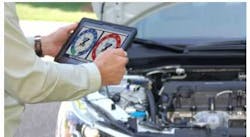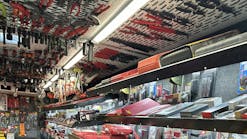HVAC systems are present on almost every vehicle today, and as these systems evolve, so do the tools needed to complete A/C service and repair.
Beginning with model year 2013, OEM’s have gradually been switching their vehicles from standard R-134a to R1234yf refrigerant. Because R1234yf is a flammable gas, it requires tools and equipment specifically designed to handle this refrigerant. As the number of vehicles using R1234yf increases, shops will need to ensure their A/C tools and equipment can handle these repairs. Knowledgeable distributors have an opportunity to help shops upgrade their tools to equipment that can handle both types of refrigerant.
Types of A/C tools
There are a variety of tools and equipment that can assist in A/C service and repair. Here is an overview of each tool type:
- Refrigerant Recovery, Recycle and Recharging (RRR) machines – These machines remove refrigerant from mobile A/C systems, recycle refrigerant and return the correct amount of refrigerant to the vehicle.
“Recovery machines are either specific to the type of refrigerant in a system or the type of system,” says Tim Wagaman, senior product manager of air conditioning and fluid products at Robinair, a company that specializes in A/C tools and equipment. “For example, R-134a systems must be serviced with a machine meeting the SAE spec for recovering that refrigerant. The same goes with R1234yf.” - Electronic leak detection – These tools help technicians find leaks in A/C systems.
- UV leak detection – “UV fluorescent dye is injected into the low-side service port, circulated, and if a leak exists, will gather at the leak site,” says Samuel Tetens, vertical marketing specialist at Tracerline, a company specializing in leak detection solutions.
- Line disconnect tools – These are often needed for older systems, and can quickly disconnect the lines for system service when lines or other components need to be replaced.
- Performance testers – This includes thermometers and hygrometers that evaluate the temperature drop at various humidity levels to determine A/C performance, says Chuck Abbot, vice president of sales and marketing at CPS products, a company that offers leak detection technologies, diagnostic tools and maintenance service solutions.
- Charging scales – Charging scales are used to meter refrigerant into a system to measure the amount of refrigerant recovered.
- Gauge manifolds – These tools monitor pressures and vacuum and recharge A/C systems.
- Vacuum pumps – Vacuum pumps remove air and moisture from empty A/C systems prior to recharging. Robinair’s Wagaman says most of these tool types are essential when it comes to HVAC service.
“For basic A/C service, shops should always have an A/C RRR machine that is approved for use on the vehicles they see most frequently, an electronic leak detector, a UV leak detection kit, line disconnect tools for older systems, a refrigerant identifier and general repair tools like a socket set, wrenches and screwdrivers,” Wagaman says.
Changes in A/C service and repair
The biggest impact on A/C service is new industry requirements for the tools used to service R1234yf and high voltage systems, says Robinair’s Wagaman. The process of recharging or repairing a system follows a similar procedure, but the equipment has to meet new standards.
“For instance, R1234yf and high voltage systems do not allow automatic oil inject using the A/C machine, per SAE standard, because different oils are used for the 12V and high voltage systems,” Wagaman explains. “Technicians will need a separate injector for these systems, ideally one for POE and one for PAG oil.”
Another change, effective January 1, 2018, is that distributors who sell refrigerant cans 2 lbs or larger must ensure that the technician is Section 609 certified, and keep refrigerant records to prove the technicians are certified. Asking, “Are you 609 certified?” ensures that you and the shops you service remain EPA compliant.
How to sell
Shop owners typically purchase most A/C repair equipment, especially larger equipment such as RRR machines. In shops that complete a lot of A/C repairs, technicians might be interested in buying smaller, less expensive items such as leak detectors or gauges. Here are some questions you can ask to effectively sell this product category.
First, ask the shop owner if they or one of their technicians is 609 certified. This will help you determine if the shop completes a lot of A/C repairs.
“If the shop doesn’t have anyone who is 609 certified, they may not perform much A/C service or see it as a large part of their business,” Robinair’s Wagaman says.
Then, ask about their current A/C service and repair equipment, particularly whether they are equipped to service R1234yf A/C systems. If the shop does not currently have the equipment to service R1234yf systems, you have an opportunity to help them upgrade their equipment so they can handle both refrigerant types.
In addition to stocking the major A/C repair tools such as RRR machines, leak detectors and refrigerant identifiers, distributors should also consider stocking filter-driers, PAG and POE A/C compressor oils and oil injectors. These are high-use items that customers will periodically need, and if it is on your truck, they can buy from you instead of ordering elsewhere. Even if a shop already has upgraded A/C repair equipment, they may still be interested in buying filter-driers and oils.
Helping shops select the right equipment
When purchasing A/C repair equipment, it is important that shops select the equipment that best fits their needs. Mike Shore, national automotive sales director at Ritchie Engineering, suggests that the following features can help shop owners decide what equipment will most benefit their shop. Ritchie Engineering is a supplier of U.S. designed and manufactured tools and equipment for the HVAC/R and automotive industries.
- Speed of the recovery process – SAE has a 30 minute recovery standard.
- Efficiency of the machine – How much refrigerant is recovered?
“The cost of R134 refrigerant is about $4 per lb,” Shore says. “The cost of R1234yf refrigerant is about $65 per lb. Thus, leak detection and machine efficiency are much more important with R1234yf.” - Time savings – Will the new equipment help technicians save time on repairs? Saving time can increase profitability on A/C repairs.
- Technical support – What kind of support does the machine offer? For what period is it offered? Does the manufacturer offer in-house support, or do they outsource to a third party?
- Equipment capabilities – Can this equipment measure temperature and pressure? Does it have an app? Is it Wi-Fi capable? Does it have a touchscreen interface? These kinds of capabilities can improve ease of use and allow remote connectivity for diagnostics.
- Volume and types of A/C jobs being performed – If a shop performs mainly R-134 repairs, they may not be as interested in R1234yf equipment because they won’t see a quick return on investment.
“Ask them what they like or don’t like about their current equipment,” CPS Products’ Abbott suggests. “Then direct them to a model that has the features the customer would like, and has none or few of the features they do not like.”
Tips for displaying and demoing
Ritchie Engineering’s Shore says that because A/C recovery machines are heavy, they aren’t easy to transport. He suggests working with the manufacturer to demonstrate these machines to customers.
“[For example], Yellow Jacket offers a demo machine for our distributors and agencies to use or place in a repair shop at their discretion,” Shore says. “Some distributors and agencies have demo rooms for other large equipment. Many store their demo machines here when not being used in the field.” CPS Products’ Abbott suggests using manufacturer’s videos and competitive comparisons to help customers understand the benefits of A/C repair equipment that may not be easy to demonstrate.
“Live demonstrations are best, but not always practical,” Abbott explains.
Robinair’s Wagaman adds that it is best to display tools out of the box and on a shelf whenever possible, so that technicians can pick up and feel the tools while they ask questions about features and uses.
“Trial programs for tools like leak detectors [can help build trust] and help techs learn how to use a tool in a way that benefits them,” Wagaman suggests.
When demoing UV dyes, distributors can use a UV light to demonstrate how the dyes fluoresce.
“Distributors can demo these products by showing the fluorescent capabilities on mock A/C systems, or by shining a UV lamp on a vial of dye/oil mixture,” Tracerline’s Tetens says.
The key to selling any product category is to demonstrate the value or time savings for shop owners and their technicians. Helping customers understand what is different about new A/C repair products or how additional tools save them time, will encourage customers to purchase these items.



